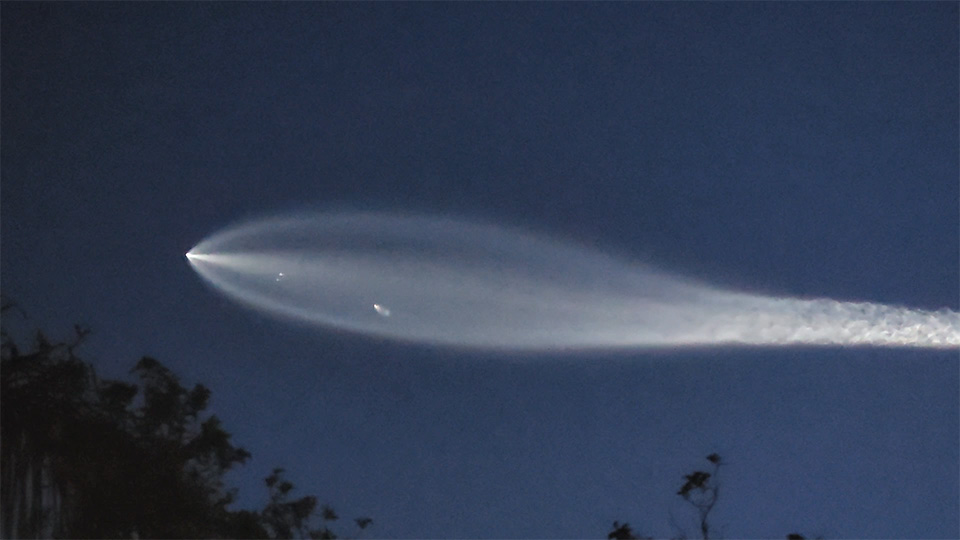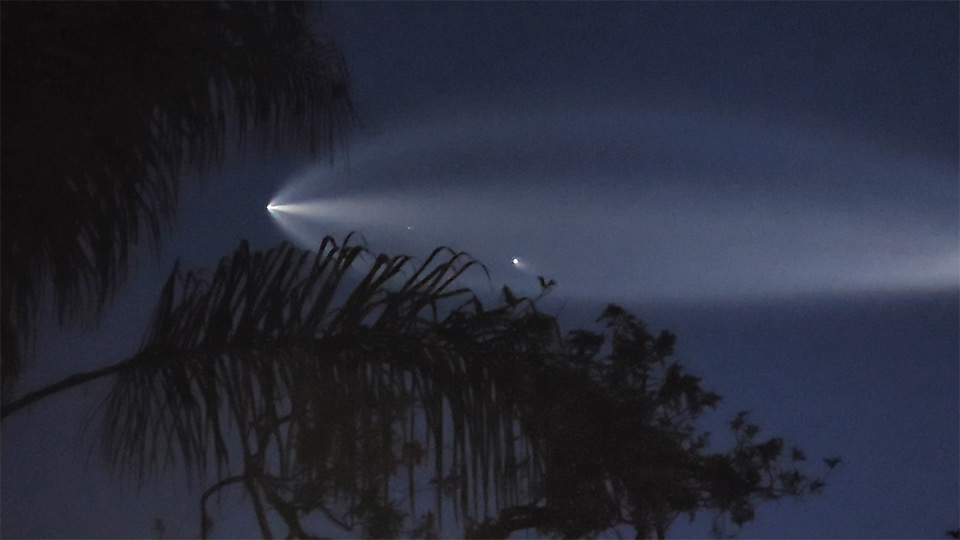astrophotography by bill w
Astrophotography
Try increasing gamma if dark sections aren't distinguished
Sunday, November 30, 2025
saturn's disappearing rings 11/23/24
Monday, October 27, 2025
ghoulish prominence
Some nice prominences from a sunny weekend:
 |
| Prominence 10/12/25 22:08 UTC |
animation from the day before (worse seeing):
 |
| Solar Prominence 30 minute animation 10/11/2025 19:37 to 19:57 UTC |
Thursday, October 2, 2025
falcon over the back bay
trying this wide field composite of the entire falcon path over the back bay
by a stroke of luck, i managed to center the rocket's arc in the wide field frame. next time i'll position more to the right to catch the arc centered over the water.
close up shows the 1st stage trail with intermittent bursts below the rocket and a smaller trail of the fairings:
Newport Back Bay
7/18/25
approximately 19:55 - 19:59 Local
nikon D850
Sigma 15mm F/2.8 EX DG fisheye
Sunday, September 28, 2025
Titan transiting Saturn 9/20/25
Saturn's iconic rings are edge-on this year--almost invisible--but this gives an opportunity to appreciate rare shadow transits as the moons (in the plane of the rings) move directly across the face of the planet.
 |
| titan and shadow crossing saturn 9/20/25 06:44 UTC |
 |
| titan and shadow crossing saturn 3 hour animation 9/20/25 05:53 - 08:54 UTC |
ZWO ASI664MC
baader IR/UV blocking filter
the sunobserver eADC
celestron 11" Edge HD, no barlow
East Bluff, CA
9/20/25 05:53 - 08:54 UTC
34 x 90 second captures for the animation
Shutter=~4.02ms
Histogram=~43%
gain 431
~244 fps
captured with firecapture
stacked in autostakkert (upsampled 1.5x)
combined in winjupos
processed in registax and photoshop
animations are individual captures at 1x
processing notes
caught the transit in process.
the seeing was not great, though improved
rings were flapping like a bird's wings.
so i'm quite happy with the final processing
at first i thought the "double black dot" was due to seeing errors,
then realized the lower was titan and the higher, darker it's shadow
the single frame is highly processed with separate processing of the core planet,
fringe and rings.
i tried biggsky on Saturn it really didn't like the 1.5 upsampled version
here it is compared to registax on 1x sampling.
seemed better than registax on the disk, but didn't handle the lower signal rings well.
Sunday, September 7, 2025
sunny day 6/28/25, bigg sky
 |
| Sun 2025-06-28 19:12 UTC, 19:20 UTC Ha composite (difference) overexposed version for outer filaments combined with negative of the central detail |
 |
| Sun 2025-06-28 19:12 UTC, 19:20 UTC Ha composite to include faint outer prominences |
 |
| Sun 2025-06-28 19:12 UTC Ha color version |
 |
| Sun 2025-06-28 Ha vs continuum (off band) conventional sunspots vs plasma filaments and prominences |
Lunt 60 PT B1200 double stacked
manual guiding with alt-azm mount
zwo ASI 174MM
Saturday, June 21, 2025
neighborhood falcon
the neighborhood turned out for a twilight falcon launch (click on the arrow twice to start the video--the audio is priceless):
first stage shut off:
second stage cruising:
 |
| the two small trailing dots are the fairings and the third further back is the first stage the first stage will land on a barge and the fairings recovered at sea |
second stage poofing out:
into the palm trees:
late second stage between the trees and into space:
(cloudy nights is the ultimate web site for amateur astronomy, sponsored by astronomics)
while you may or may not want the iconic grey shirt
the "pitches" on the web site are priceless with the writer channeling J Peterman
so for all you fans of Seinfeld and astronomy (you know who your are)
you must go to the web site and check out the pitches
https://astronomics.com/collections/cloudy-nights-t-shirts/products/cloudy-nights-short-sleeve-t-shirt
6/16/25 8:41-8:44 PM local
Eastbluff, CA
Samsung galaxy S22 ultra
"come here quick..."
then softly as if to avoid disturbing the rocket
"...it's right over our house"
First try...
The Cloudy Nights T-Shirt
(Now with 47% more mystique.)
It was the spring of 1997. Somewhere between the Mojave and a memory, a man named Skip Donnelly sat cross-legged in the back of a rust-orange VW van, peering through a hand-polished 6" Newtonian and waiting for Hale-Bopp to clear the horizon.
He hadn’t slept in three nights. He’d been living off gas station trail mix and a dream. His only companion? A local coyote who seemed to admire his collimation skills.
Skip wore this shirt—or one eerily similar.
It’s Graphite Heather, though he’d just call it “night sky gray.” Softstyle fabric with the kind of 65/35 poly-cotton blend you could sleep in on a moonlit truck bed. It absorbed both dew and regret in equal measure. By morning, the comet came. Bright. Relentless. Eternal.
Skip wept.
He never made it back to Phoenix. Some say he followed the comet, westbound. Others claim he founded a secret astronomy club in Taos that meets only during solar minimum.
We can’t say for sure. But we can say this:
You don’t just wear the Cloudy Nights T-Shirt.
You inherit it.
Second try...
The Cloudy Nights T-Shirt
It was 2:17 a.m. in the high desert of New Mexico.
A lonely astronomer stood beside his Dobsonian like a sentry, hand wrapped around a thermos of coffee that had long since gone cold. Above him, Saturn hovered like a jeweled ringbox in a sea of ink. His fingers trembled—not from the chill, but from awe. And the shirt he wore? It wasn’t just a shirt. It was a declaration.
This is that shirt.
Crafted from a supple blend of 65% polyester and 35% cotton, this Graphite Heather short sleeve garment has seen things—cosmic things. It breathes like a mountain breeze and fits like the warm memory of your first clear sky chart. The logo is discreet, like a secret handshake at a Messier Marathon. The fit is modern, but forgiving. The cut, understated but purposeful.
Available in sizes Small through 4XL for observers of every focal length and flange distance.
You don’t just wear the Cloudy Nights T-Shirt.
You live in it.
And now the one that makes sense to just about everyone.
Cloudy Nights Short Sleeve T-Shirt – Graphite Heather
Show your love for late nights, clear skies, and the community that helps you navigate them both. This official Cloudy Nights t-shirt is printed on a soft, breathable Gildan Softstyle tee in a versatile Graphite Heather color. Whether you’re polar aligning at dusk or just grabbing coffee in town, it’s a comfortable way to rep the world’s largest astronomy forum.
Made from a durable 65/35 polyester-cotton blend, this shirt holds its shape and stays comfortable through long nights and many washes. Lightweight, soft, and just structured enough to keep from looking like a wrinkled star chart.
Available in sizes Small through 4XL—because we support big scopes and big style alike.
Sunday, April 20, 2025
stupid venus tricks--inferior conjunction
 |
| Venus inferior conjunction 3/22/25 3:21 PM local 22:21 UTC 1% illuminated 8 degrees 25 minutes from the sun |
and when you see a really bright star in the early morning it's probably...venus.
passing between the earth and the sun,
usually just missing the sun,
switching from the evening to the morning star.
this event is called the inferior conjunction of venus (with the sun), the superior conjunction occurring on the far side.
the cool thing about the inferior conjunction is that the crescent is a thin as it can possibly get. if the separation from the sun is small enough, the crescent may even go more than half way around the disk due to atmospheric refraction*
observe (or photograph) venus in the middle of the day when it is as close to the sun as possible. needless to say, this is DANGEROUS. one glimpse at the sun through a high power telescope is likely to fry your retina, melt optics, or possibly explode telescopes. so one needs to be very careful.
the inferior conjunction before last was hampered by clouds. i caught a quick visual glimpse, but didn't have time for an image.
last time it was hot, sunny and very windy. my goto wasn't working well and a lens cap blew off while i was centering on the sun, causing an unplanned modification of my finder scope, leading me to abandon the attempt:
 |
| hole burnt in finder-scope lens cap it's actually pretty handy |
this time i caught it (above), though sadly, i did not catch a more circumferential crescent.
venus transits (crossings directly across the face of the sun) are extremely rare, the last was in 2012, and next will be 2117. and yes venus is retrograde when this occurs for you astrologers.
i was fortunate enough to catch the rare 2012 transit with a brand new solar telescope:
*i think
https://earthsky.org/astronomy-essentials/inferior-conjunction-venus-between-sun-and-earth/
https://skyandtelescope.org/astronomy-news/venus-sprints-from-evening-star-to-morning-star/














